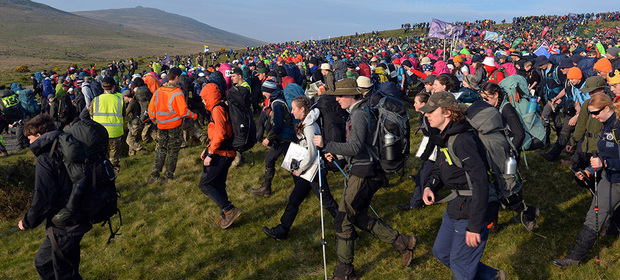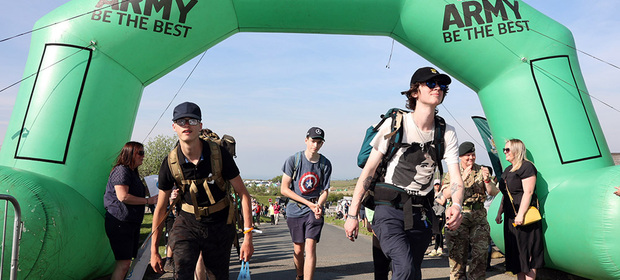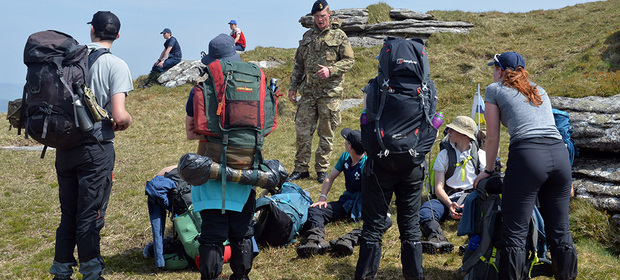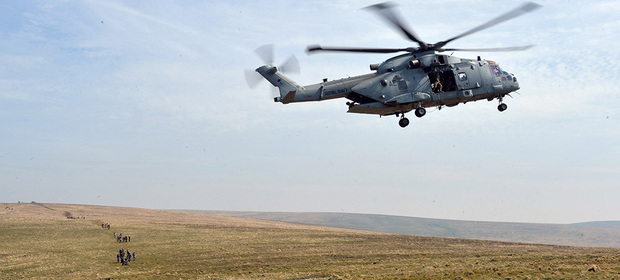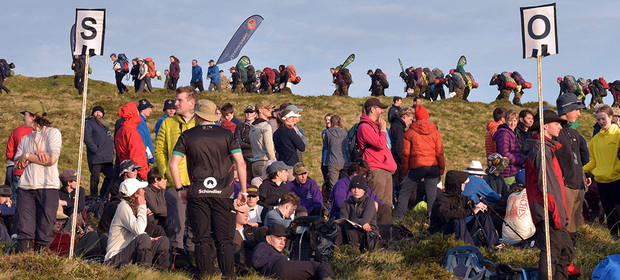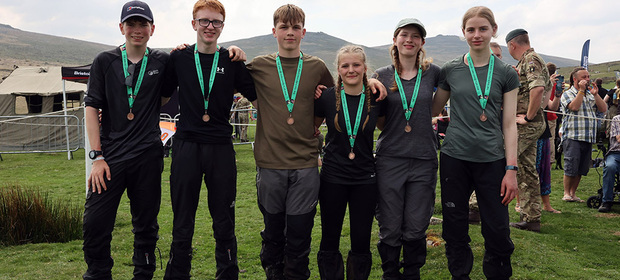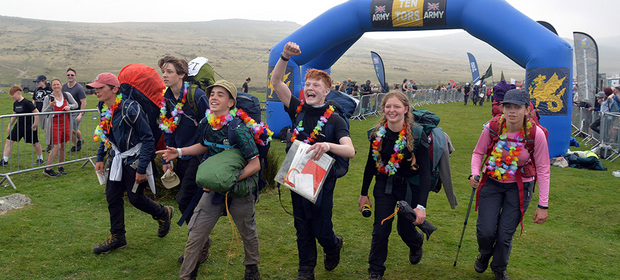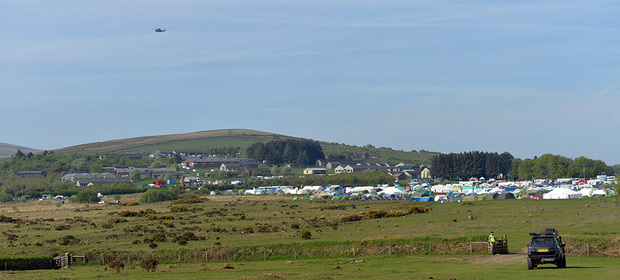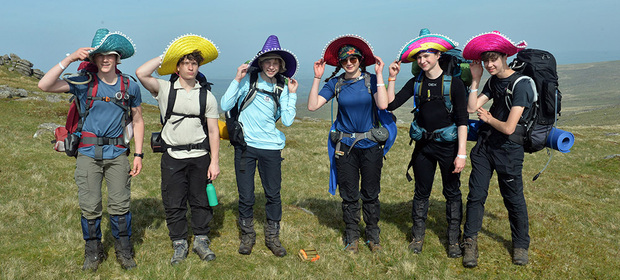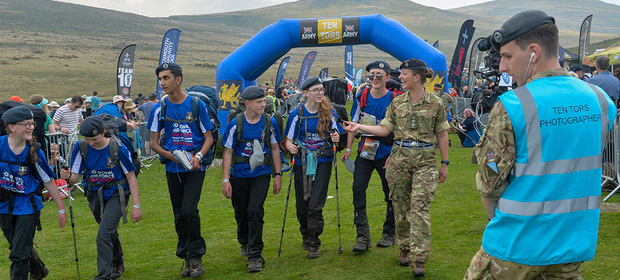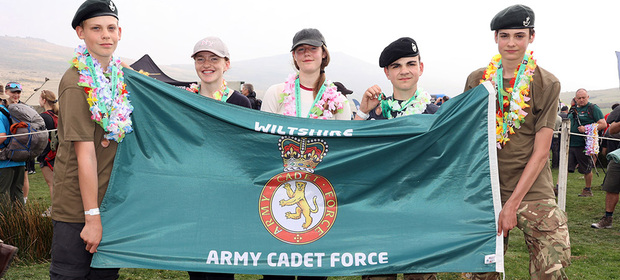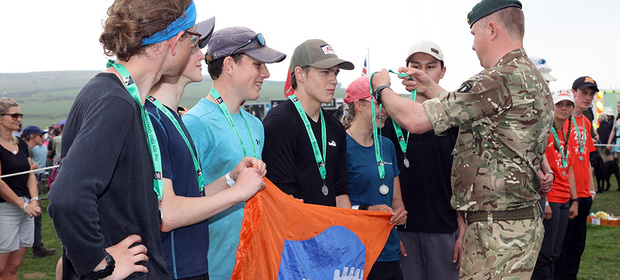The Very Beginning
How often do we all have good ideas but do nothing about them – either because we simply cannot, or because we cannot be bothered? That an idea could emerge from a casual conversation in September 1959 to become a major event which has now celebrated over fifty years of success is little short of a miracle. That success is undoubtedly due principally to two people – Colonel Gregory, who commanded the Junior Leaders Regiment at Denbury and Captain (later Major) John Joyner, who was the unit’s Adventure Training Officer. ‘Greg’, as all his friends knew him, has long been recognized as the Founder of Ten Tors, but it was John who was its ‘architect’ and who designed its routes and produced checkpoint instructions for the first ten years.
“In September 1959,” John subsequently explained, “I wrote an exercise for the Junior Leaders called ‘Escape to Freedom’. The narrative was based on the escape of the Dalai Lama from Tibet. In the course of the exercise an escaping VIP was to be escorted through enemy territory to freedom. On its second day I took Colonel Gregory and another officer out to Teignhead Farm. We camped near the source of the River Teign, and on a lovely evening and just before dark we set out across the moor to the upper reaches of the River Dart to see how things were going. We arrived at the spot where the VIP was to spend the second night of his ‘escape’, and we quickly discovered that the exercise was proving to be a great success. Those taking part were thoroughly enjoying the challenges of navigation, bivouacking, and field cooking.
“We left the Dart at about midnight to return to our own bivouacs, and during the walk back on a lovely starlit night we talked about modern youth, about the problems of providing adventurous pursuits, and about people who would complain about youth but do nothing to help. We felt that we at least were doing something, but were we doing enough? Why should our activities be confined to Junior Leaders? Why not make it possible for less privileged civilian youths to do something similar? It was when we reached the idea of getting girls as well as boys to take part that we nearly lost our way, and, but for the fact that I had taken the precaution of leaving a lighted hurricane lamp outside my tent, I think we would certainly have become lost! Navigation, not always easy on Dartmoor by day, can be very difficult at night!
“Shortly afterwards I wrote a squadron exercise which required small patrols to visit ten tors, where they would discover the progress of the General Election that was taking place at that time: I called this exercise ‘Ten Tors’. I then wrote a similarly named exercise - this time for the whole Regiment - that was to take place during the Signal Officer-in-Chief’s visit on 27 November 1959. These two exercises could really be said to be the first ‘Ten Tors’, but it was not until 15 September 1960 that the first ‘public’ event of that name took place.”
For the brochure announcing that first ‘public’ event Colonel Gregory wrote: “I have thought a great deal about Ten Tors and wondered how I could set about organising it for 1960. ‘Too big an undertaking’ says one authority. ‘The farmers will be up in arms’ says another. ‘It will be too expensive’ murmurs the nuts and bolts man. ‘It will be an awful flop if nobody turns up’ prompts the pessimist. ‘But go ahead’ urges the (imaginary) Prince of Denbury. ‘Get on with it and rely on youth. The vital, tremendous, indefatigable youth of Britain will always rally to a good cause. Give them a place to camp, water to wash in, a few latrines, and that is all they need. Above all, give the whole undertaking an atmosphere of goodwill and trust, and be sure that it will succeed beyond your wildest dreams.”
The March 1960 edition of the “Junior Mercury” (the Junior Leaders Royal Signals newspaper) carried a report by Junior Lance Corporal Zimmer of the Kukri Troop. He had been invited as a reporter for the paper to witness the preparations for the forthcoming “Ten Tors”. He joined Colonel Gregory and Major R W (Ralph) Nye, the Senior Education Officer, on a “planned trip over the Ten Tors”. This was his account:
“We left camp early one Wednesday morning with Major (the Commanding Officer’s dog) jumping joyously around us. During the walk Colonel Gregory was vainly trying to bring Major to heel but with little success. Major Nye suggested that a higher pitched voice might prove more successful. Therefore for the next mile or so we had to contend with the CO sounding rather like an out-of-work opera singer!
“Arriving at Hay Tor Rocks we found a party of girls from Holne Outward Bound School engaged in rock climbing. (Here the paper’s editor commented: ‘Surprisingly the report doesn’t end here!’) From then on it seemed all walking up and down until finally we camped down for the night, a hot meal and coffee being very acceptable.
“The next day was bitterly cold. It started to snow, and the monotony of the walk was only enlivened by the CO falling into a bog! Late afternoon found us on top of a tor brewing up something to eat. It was snowing heavily, and finally we decided to give it up and go home. Thirty-two hours had passed since leaving camp, and we had covered only seven of our ‘Ten Tors’. The questions remaining to be answered are: Are ten tors too many? Is the time limit too short? Were these the wrong tors? Was the course too hard? Was it the weather’s fault?”
On 26/27 June 1960 Major Ralph Nye and Captain John Joyner walked the “best order” of their planned tors “to see how we get on”. Up to then it had been considered that Ten Tors could start and finish at Denbury Camp. As John Joyner later wrote: “Because of firing on the ranges we had to start part way round our chosen route. On the second day we arrived at Denbury in time to have a fine rice lunch on the Officers Mess lawn. It was then that we realised that even our chosen route would be much too long, and so we decided to use transport to Haytor and to continue walking from there. Thus Haytor was selected as the starting point, and we had to include the means to bus all those taking part from Denbury to Haytor. It proved to be a most spectacular place from which to start especially with the Junior Leaders Regiment Band playing on top of the tor.”
So it was that Ten Tors 1960 was planned to take place on 15-16 September of that year. It was described in the brochure as “a Youth Expedition across Dartmoor for young men and young ladies” (sadly none of the latter applied to enter) “under the distinguished patronage of the Lord Roborough (the Lord Lieutenant of Devon), Major General J H Cubbon CBE, Sir Ralph Rayner and Lady Sayer.”
Colonel Gregory was to be the Chief Controller, and Major Nye and Captain Joyner the joint Secretaries. Assembly was to be at Denbury Camp on Wednesday 14 September, and all participants were to be bussed to Haytor next morning for a Start at 7am by General Cubbon. The Finish was to be on Friday at Denbury Camp. The entrance fee was “one guinea per ‘patrol’ plus £1 bus fare”. Each patrol of ten “young men” aged 16 to 18 (or ten “young ladies” had there been any) would be told to visit ten tors in any order: the best order, which they would not be told, would produce a route of just over fifty miles. The tors were to be: Haytor (the Start), Thornworthy, Hound, Oke, Yes, Lints, Stannon, Hare, Fur, Yar, and (permissible because the start was at a tor!) Cranmere Pool. “Patrols” would be required to complete the course in 36 hours with no “marching” between 8pm and 6am – a total marching time of thirteen plus thirteen hours. The stated requirements were: “good navigation, carefully planned kit so that essentials are taken but weight is kept to a minimum; and ten good walkers with the will to keep going.”
The entrants were twenty Services patrols of ten members, plus one civilian patrol from Exmouth Youth Club comprising only three members. Two Dartmoor maps and the list of tors to be visited were issued in a sealed envelope at Haytor immediately after the Start ceremony. The weather was fine on Thursday, but heavy showers early on Friday were followed by continuous rain in the afternoon and evening. A patrol from RAF Halton was the first to reach Denbury Camp, and it was followed by five other complete patrols. Forty-one individuals additionally finished having lost some of their fellow patrol members. A jamboree was staged on Saturday during which the patrols that had finished complete received Ten Tors medals designed by Lieutenant Peter Tysoe and successful individuals received inscribed certificates. At the end all patrols, led by the RAF, participated in a march past, and a dance then followed.
Subsequently it was agreed that September was not an ideal time for schools, and Ten Tors 1961 took place during the Whit Bank Holiday weekend. Captain (later Major) John Joyner, already referred to here as the ‘architect’ of Ten Tors, went on to design the routes and produce checkpoint instructions for all of the first ten ‘Expeditions’.
The success of Ten Tors was marked by the patronage of His Royal Highness The Duke of Edinburgh, KG, KT. and there were other patrons too: The Lord Lieutenant of Devon, Lord Roborough; Brigadier Sir Ralph Rayner, MBE; Lady (Sylvia) Sayer; Admiral Sir Nigel Henderson, KCB, OBE; Air Marshal Sir Donald Evans, KBE, CB, DFC; Major-General F J Swainson, OBE; Major-General J R Holden, CBE, DSO, Brigadier J B Ashworth, CBE, DSO, ADC; Rear Admiral D J Hoare, CB, who together formed a ring of encouragement around the junior leaders from which they could emerge with confidence to take the risk and adventure.
The Ten Tors prayer
The Ten Tors prayer was first intoned at the second ever event, in 1961 at the then start at Denbury Camp. According to painstaking research by the Ten Tors archivist, Alan Stephens, it has been twice reworded over the intervening years, but Alan's work has uncovered the original, which is:
"O God, who has made the earth of great beauty
and instilled in man a spirit for adventure,
we thank you for the beauty of nature
for the courage and vigour of youth
for companionship
and for the opportunity to enjoy these gifts
Go, we pray, with all who are setting out
on this great venture
among the tors of a unique and ancient moorland.
Grant that, by meeting each challenge and difficulty
with honest endeavour and unselfish courage
they may find a spirit of determination and
true comradeship
that will benefit themselves and those about them
both now and in the future."Amen
The version used at later events, until the original was rediscovered and used for the start of the fiftieth anniversary of Ten Tors in 2010, is
"O God who has made the Earth of great beauty,
and who has given us the Spirit of Adventure,
we thank you for the beauty of the world,
for the courage and vigour of young people,
for the companionship and for the opportunity
to enjoy all these gifts.
We pray that you will keep them safe on this great venture
and grant that they may meet each challenge
and difficulty with unselfish courage and so find the
true spirit of comradship as shown to us by
Jesus Christ, our Lord."Amen
(from the Ten Tors Event programme, and with grateful thanks to Alan Stephens).

